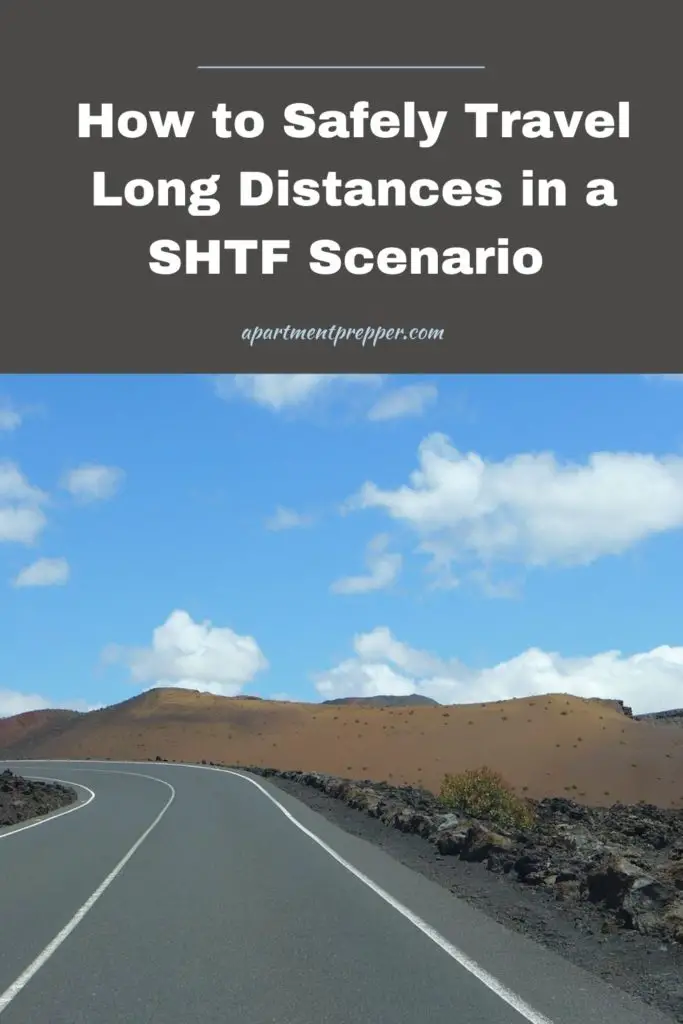Written by Martin Banks
Surviving in a SHTF scenario is about more than creating a safe place to shelter in. At some point, you may have to travel, whether it’s to get to your shelter or leave a dangerous area. If you have a long distance to cover, that could be challenging.
Long-distance travel generally isn’t ideal in a SHTF scenario, but it may be necessary. Since you never know how the situation may play out, it’s best to plan for these trips ahead of time. Here’s how you can plan accordingly to cover long distances safely.
Calculate Your Route Carefully
The first step to safe travel is to plan your route before setting out. That includes what roads you’ll take to reach your destination as well as any backup routes if your first choice becomes inaccessible. Your course should get you to your destination quickly, but you should also consider safety, fuel efficiency, and availability of supplies.
Most modern cars can go 30 to 50 miles before running out of fuel after the gas light comes on. Keep that and your specific vehicle’s average mileage in mind as you plan your route and decide how much spare fuel to take with you.
You’ll also have to consider supplies. The average person needs one gallon of water and roughly 2,000 (depending on weight) calories of food per day. If you can’t carry all of that with you, plan your route along areas where you can refresh those provisions.
Try Not to Stand Out
Another thing to consider is blending in. Depending on the SHTF scenario in question, standing out to others could make you a target. Even in a milder situation, carrying many weapons and supplies could make you look suspicious. Authorities may stop you, introducing more complications or delaying your journey.
It’s best not to stand out. Carry all the supplies you need, but conceal them as much as possible. At most, you want to look like a typical family on vacation, so you don’t arouse suspicion and can pass through quickly and safely. Choose your clothing, vehicle, and storage methods accordingly.
Map Out Camping Spots Ahead of Time
Depending on how far you have to go, you may not be able to complete your journey in one day. While it may be tempting to drive through the night to get there as soon as possible, that’s not advisable. Sleep deprivation is dangerous when driving and can harm your immune system.
If you can’t make your trip in a single day, plan out camping spots in advance. Map out camping sites so you can reach one from another before it gets dark. That will help you navigate and set up camp safely.
It’s also a good idea to plan these camping spots away from main roads or other busy areas. Staying secluded will help you avoid any potential complications that come with running into others.
Consider Caching Supplies
If you know you’ll need to make a long-distance trip in a SHTF scenario, you should consider caching. This involves placing hidden supplies of food, medical equipment, ammunition, or other materials. These caches will help you minimize what you carry on your person, helping you maintain a low profile.
Supply caching could save your life if you end up in a situation where you lose everything you had on hand. Plan these reserves around your pre-planned route, possibly along backup routes, too. Try to keep them as hidden as possible and use combination locks so you can access them without a key.
Watch the Weather
One consideration that may easily slip your mind is the weather. Nature can be just as dangerous as other humans, especially when traveling. Snow, rain, ice, and high winds can make driving unsafe, so always keep an eye on the weather.
You probably can’t see the weather from an app or TV station in a SHTF situation, but you can still predict it. The Farmer’s Almanac has historically been around 80% accurate in predicting the weather, so it can be a helpful resource. You should also check the sky and watch animal behavior to anticipate any incoming storms or poor visibility.
Move Only When It’s Safe
Finally, remember that it’s often safer to stay still than to move. While you want to arrive as quickly as possible, safety is more important than speed. If you can, wait until it’s safe to start moving, whether you’re just starting your journey or moving from one campsite to another.
Before setting out, try to learn more about your location and take in your surroundings. Is there heavy traffic? Is there a storm approaching? Are there any suspicious groups roaming the area? Asking questions like this can help you decide if it’s safe to start moving.
You specifically want to look for things that would make driving unsafe, like poor weather or obstacles on the road. The last thing you want is to get stuck in the middle of a highway or crash your vehicle because you left too early.
Long-Distance Travel Is Challenging but Not Impossible
Even outside of a SHTF scenario, long-distance travel can be intimidating. However, if you know how to prepare and plan accordingly, it doesn’t have to be dangerous.
Long-distance travel in a SHTF situation is like any other part of emergency preparedness. If you plan for a worst-case scenario and know what to expect, you can remain safe.
About the author
Martin Banks is the managing editor at Modded. Follow him on Twitter @TModded for frequent updates on his work.
If you found this article interesting or helpful, please consider helping us out (without costing you anything)! We are an affiliate of Amazon.com, which means we received a small commission if you click through one of our Amazon links when you shop, at totally no cost to you. This helps keep the lights on at the blog. Thanks!



you really need to study real life bug-out After Action Reports – best we have for the US is for the hurricane evacs >>> big difference will most likely be the random violence & looting along the evac routes ..
if you have any ideas of a long distance bug-out – it better be prepped – better be high on daily intel gathering & evaluation to get an advance warning >>> you need to be AHEAD of the sheeple refugee wave and not among it and most certainly behind it ….
TIME will be of the utmost importance – especially if your route includes crossing state borders >>> it’s almost a miracle that state blockades weren’t enacted for Covid – you can expect them for many of the major SHTFs >>> DRIVE like there’s no tomorrow – if you don’t – there might not be a tomorrow for you
Hi Illini Warrior, Agreed, there would likely be danger due to violence and looting along the routes, possibly newly installed road blocks. Thanks for the comment!
better be able to read the tea leafs LONG before everyone else. 95% of Americans are clueless. Today, people are killed for shoes, phones, $5, or just because. You’d be lucky to escape a metro area and if we’re talking calories and water needed for a move, Forgetaboutit. Lock and load and prepare to defend yourself.
Hi 101st Airborne, So true, people are attacked/killed for possessions or just no reason at all. Everyone needs a way to defend themselves. Thanks for the comment.
I know this flies in the face of common sense but I will stay put in the urban core, as most people flee it will free up places to go if my main residence has been destroyed. I guess I’m trying to do the opposite of what everybody else will be doing and staying closest to the most resources. It won’t be easy, but easier than roaming across the country.
Hi OldIron, Good thinking, staying put where you know the area instead of wandering around. Thanks for the comment.
I hate to bring this up but in Todays America it needs to be said when it comes Prepping and Bugging out especially Bugging out of a large Urban Area like say New York City. I am talking about Race and Ethnicity. If you plan on bugging out and you are a minority I would be Exremely! Extremely! careful about where you choose to go.
If you live below the Mason Dixon line and you are Black, Brown or Asian/Middle Eastern I would not venture towards Rural Areas unless it is a main road. You need to look no further than a few years ago when the Syria/Yemen Fiasco happened and the Middle Eastern Refugees were treated like sub humans in EASTERN EUROPE Where Ukraine is, I am going to point out the fact that Ukrainians are being welcomed with open arms in the neighboring countries that did not happen to the Middle Eastern Refugees quite the opposite. Those of you of color should take note of what happened a few very short years ago.
Look at America with Todays Divisive Politics and Festering Racial Hatred, I loathe to say it but if you are a person of color your only choice is to probably go North or Northwest Staying away from Certain Rural areas. It is a sad fact of life in Todays America but a fact nonetheless.
Hi Ed, This does bear mentioning, you have to be careful where you choose to go in a bug out situation, not every destination may be safe.
If at all possible; DO NOT TRAVEL IN A NEW VEHICLE( one that’s less than five to ten years old). It also might help if you travelled in a USED vehicle. Or one that looks old. Do not make it look like a “bug out” vehicle( no visible gun racks. or a winch on the front bumper). Try to make it an AMERICAN VEHICLE.
1) Do NOT travel in NEW vehicle. Try to find one that about five to ten years old.
2) Do NOT make it look like a “BUG OUT” vehicle(no visible gun racks. or a winch on it’s front bumper).
3) If you’re not going to be driving off road; do not choose a pick up truck. or an S.U.V. . Especially a 4×4 one.
4) consider where you’re travelling to. Select a vehicle that won’t look out of place( how often do you see a pick up truck in New York City?).
Hi Jonescrusher, These are all great tips to avoid calling attention to yourself. Thanks for the comment.